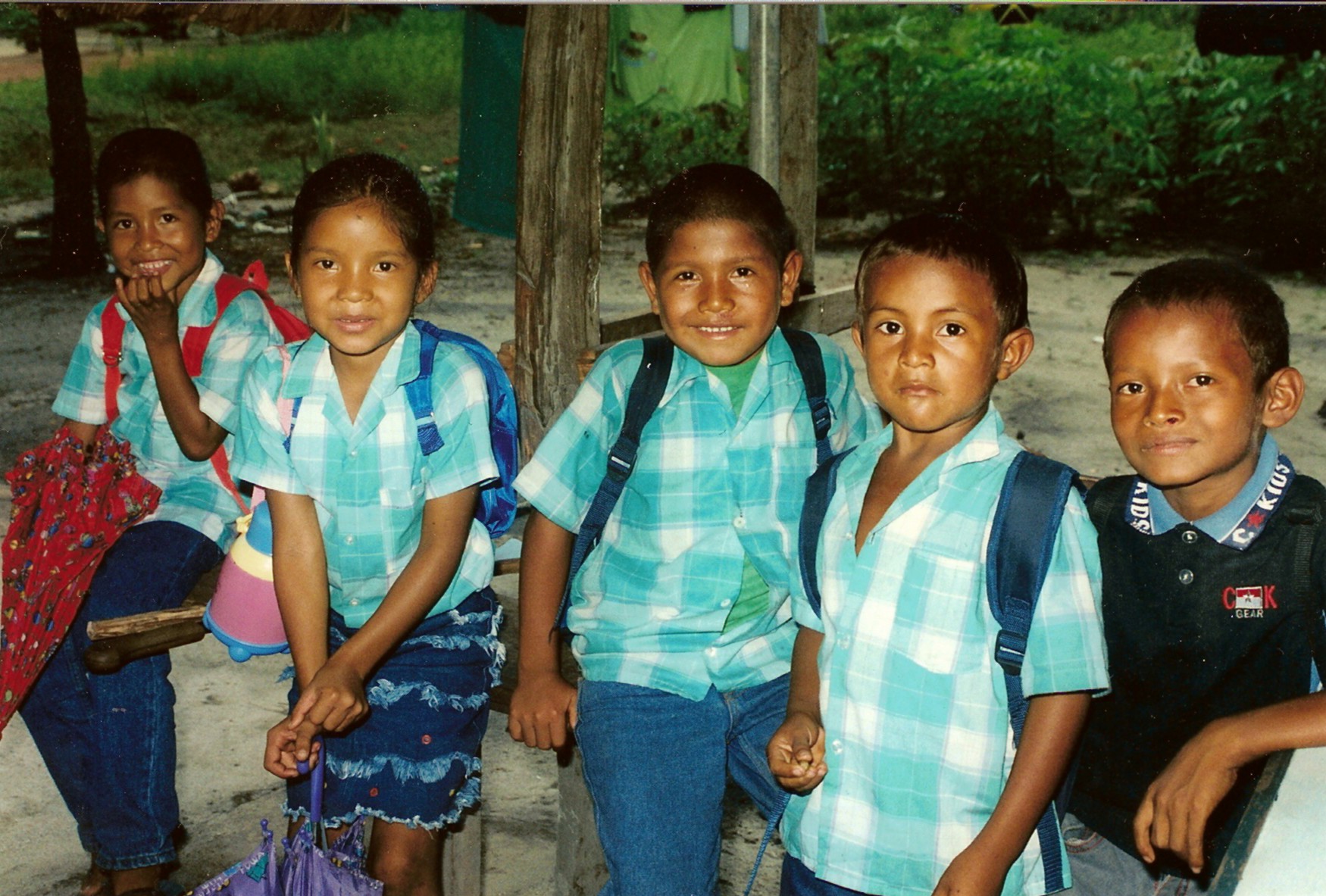|
Karipuna Do Amapá
The Karipuna do Amapá (also: Karipúna) are an indigenous people located in the riverine areas of the Brazilian state of Amapá, particularly around the Caripi River. In 2014, the population was estimated at 2,922 people. History The Amerindians use the term Karipuna, because they are mixed or civilized Amerindians. The tribe is the result of several migrations, and mixing with non-indigenous people. The main groups being Amerindian, French Guianese, Saint Lucian Arabs, and Chinese. In 1830, the Cabanagem Revolt resulted in the migration from the mouth of the Amazon River to the region. The Karipuna had long been in contact with French Guiana, French Guianese which intensified during the gold rush of 1854 in Approuague. They used to speak the now extinct Karipúna do Uaçá language, but by 1900, Karipúna French Creole had taken over. The borders between French Guiana and Brazil were not clear, and therefore, the area between the Amazon River, Amazon and the Oiapoque River, O ... [...More Info...] [...Related Items...] OR: [Wikipedia] [Google] [Baidu] |
Indian Day (Brazil)
In Brazil Indigenous Peoples Day (), observed annually on April 19, recognizes and honours the indigenous peoples of Brazil. The date was created by President Getúlio Vargas by a decree in 1943 and recalls the day (April 19) in 1940, in which several indigenous leaderships of the Americas decided to attend the First Inter-American Indian Congress, held in Mexico. The observance name was changed from "Indian Day" () in 2022. Nowadays most part of the cities does not celebrate the date, however it is very common for schoolchildren across Brazil to dress up like Natives and visit Museums to learn more about the first Brazilians. It is common to see celebrations in states with a relatively large indigenous population, such as Mato Grosso, Mato Grosso do Sul, Pará, Goiás Goiás () is a Brazilian States of Brazil, state located in the Central-West Region, Brazil, Central-West region. Goiás borders the Federal District (Brazil), Federal District and the states of (from no ... [...More Info...] [...Related Items...] OR: [Wikipedia] [Google] [Baidu] |
Résidence Arc-en-ciel
Résidence Arc-en-ciel (English: rainbow residence) or BP 134 is a Brazilian village in the commune of Remire-Montjoly in French Guiana, France. A large part of the population are Karipuna do Amapá Amerindians. Overview The Karipuna do Amapá Amerindians used to live in a disputed territory between French Guiana and Brazil. In 1900 their territory was awarded to Brazil, however their primary language is Karipúna French Creole due to prolonged contact with French Guianese. A group of Karipuna squatted an area near Remire-Montjoly on the outskirts of Cayenne Cayenne (; ; ) is the Prefectures in France, prefecture and capital city of French Guiana, an overseas region and Overseas department, department of France located in South America. The city stands on a former island at the mouth of the Caye .... The village was originally known as BP 134. Other Amerindians joined them, and were followed by people from other parts of Brazil. By 2009, the population of Résidence Arc-e ... [...More Info...] [...Related Items...] OR: [Wikipedia] [Google] [Baidu] |
Cayenne
Cayenne (; ; ) is the Prefectures in France, prefecture and capital city of French Guiana, an overseas region and Overseas department, department of France located in South America. The city stands on a former island at the mouth of the Cayenne River on the Atlantic Ocean, Atlantic coast. The city's motto is "fert aurum industria", which means "work brings wealth". Cayenne is the largest Francophone city of the South American continent. In the 2021 census, there were 151,103 inhabitants in the metropolitan area of Cayenne (as defined by INSEE), 63,468 of whom lived in the city (communes of France, commune) of Cayenne proper. History Ignored by Spanish explorers who found the region too hot and poor to be claimed, the region was not colonized until 1604, when the French founded a settlement. However, it was soon destroyed by the Portugal, Portuguese, determined to enforce the Treaty of Tordesillas. French colonists returned in 1643 and founded Cayenne, but were forced to ... [...More Info...] [...Related Items...] OR: [Wikipedia] [Google] [Baidu] |
Oyapock River Bridge
The Franco-Brazilian Binational Bridge spans the Oyapock River, linking the cities of Oiapoque in Amapá, Brazil and Saint-Georges-de-l'Oyapock in French Guiana, France. The bridge is cable-stayed bridge, cable-stayed, with two towers rising to a height of and a length of . There are two lanes for vehicles with a total width of and a pedestrian sidewalk with a width of . The vertical clearance under the bridge is . Its construction was completed in August 2011. However, due to delays in the construction of Brazilian checkpoint facilities, the bridge was not open to traffic for many years. The bridge's designer was the Italian engineer Mario de Miranda. The inauguration ceremony of the bridge finally took place on 18 March 2017. Starting from 08:00 on 20 March 2017, the bridge has been open to members of the public. The bridge is toll-free and is accessible to both private cars and pedestrians. On the French side, there is a border checkpoint staffed by three governmental agen ... [...More Info...] [...Related Items...] OR: [Wikipedia] [Google] [Baidu] |
Galibi Marwono
The Kalina, also known as the Caribs or mainland Caribs and by several other names, are an Indigenous people native to the northern coastal areas of South America. Today, the Kalina live largely in villages on the rivers and coasts of Venezuela, Guyana, Suriname, French Guiana, and Brazil. They speak a Cariban language known as Carib. They may be related to the Island Caribs of the Caribbean, though their languages are unrelated. Name The exonym ''Caribe'' was first recorded by Christopher Columbus. One hypothesis for the origin of ''Carib'' is that it means "brave warrior". Its variants, including the English ''Carib'', were then adopted by other European languages. Early Spanish colonizers used the terms ''Arawak'' and ''Caribs'' to distinguish the peoples of the Caribbean, with ''Carib'' reserved for Indigenous groups that they considered hostile and ''Arawak'' for groups that they considered friendly. The Kalina call themselves ''Kalina'' or ''Karìna'' , spelled variousl ... [...More Info...] [...Related Items...] OR: [Wikipedia] [Google] [Baidu] |
BR-156
BR-156 is a federal highway of Brazil. The road consists of 552 km between Oiapoque and Macapá, and 271 km between Macapá and Laranjal do Jari (except via Santana city), totalling 823 km of road through forest and savannah. Only the road between Macapá and Calçoene is paved with asphalt. The rest of the road has a dirt surface. Because of the road conditions, it takes around 10-12 hours to drive between Oiapoque and Macapá. With the Oyapock River Bridge (linking the cities of Oiapoque in Brazil and Saint-Georges-de-l'Oyapock in French Guiana) open to traffic starting from 20 March 2017, it is now possible to drive from Macapá to Cayenne, the capital city of French Guiana French Guiana, or Guyane in French, is an Overseas departments and regions of France, overseas department and region of France located on the northern coast of South America in the Guianas and the West Indies. Bordered by Suriname to the west .... References Federal highways in Brazi ... [...More Info...] [...Related Items...] OR: [Wikipedia] [Google] [Baidu] |
Oiapoque
Oiapoque () is a municipality in the north of the state of Amapá, Brazil. Its population is 27,906 and its area is . Oiapoque is also a major river in the same state, forming the international border with French Guiana. The Oyapock River Bridge, connecting the village with Saint-Georges in French Guiana, was completed in 2011 but not opened to pedestrian or vehicle traffic until 2017. Lying on the northern coast of Brazil, Oiapoque is popularly considered the northernmost point of Brazil. The phrase ''do Oiapoque ao Chuí'' ("from Oiapoque to Chuí") means "all of Brazil." However, there are more northerly points in Roraima state such as the municipality of Uiramutã. Oiapoque remains the northernmost coastal city of Brazil, and the northernmost city of Amapá. It occupies more than half of the north border of the state. Early history The Oiapoque River was visited by Europeans in the first years of the 16th century. The first European was the pirate Vicente Yáñez Pinzó ... [...More Info...] [...Related Items...] OR: [Wikipedia] [Google] [Baidu] |
Galibi
The Kalina, also known as the Caribs or mainland Caribs and by several other names, are an Indigenous peoples of the Americas, Indigenous people native to the northern coastal areas of South America. Today, the Kalina live largely in villages on the rivers and coasts of Venezuela, Guyana, Suriname, French Guiana, and Brazil. They speak a Cariban language known as Carib language, Carib. They may be related to the Island Caribs of the Caribbean, though their languages are unrelated. Name The exonym ''Caribe'' was first recorded by Christopher Columbus. One hypothesis for the origin of ''Carib'' is that it means "brave warrior". Its variants, including the English ''Carib'', were then adopted by other European languages. Early Spanish colonizers used the terms ''Arawak'' and ''Caribs'' to distinguish the peoples of the Caribbean, with ''Carib'' reserved for Indigenous groups that they considered hostile and ''Arawak'' for groups that they considered friendly. The Kalina call them ... [...More Info...] [...Related Items...] OR: [Wikipedia] [Google] [Baidu] |
Palikur
The Palikur are an Indigenous people located in the riverine areas of the Brazilian state of Amapá and in French Guiana, particularly in the south-eastern border region, on the north bank of the Oyapock River. The Palikur Nation, or ''naoné'', is Arawak-speaking and socially organized in clans. In 2015, the estimated population was 2,300 people of which 1,400 lived in Brazil and 900 in French Guiana. Names The Palikur people are also known as the Paricuria, Paricores, Palincur, Parikurene, Parinkur-Iéne, Païkwené,"Palikur: Introduction." ''Povos Indígenas no Brasil'' (retrieved 4 Dec 2011) Pa'ikwené, Aricours, Aukuyene, Karipúna-Palikúr, Palicur, Palijur, Palikour, Paricura, Paricuri, or Parucuria people. History The location of the Palikur near the mouths of the |
FUNAI
is a Japanese consumer electronics company headquartered in Daitō, Osaka. Currently, it is in liquidation. Apart from producing its own branded electronic products, it was also an OEM providing assembled televisions and video players/recorders to major corporations such as Sharp, Toshiba, Denon, and others. Funai supplies inkjet printer hardware technology to Dell and Lexmark, and produces printers under the Kodak name. Its United States–based subsidiary Funai Corporation, Inc., based in Torrance, California, markets Funai products in the US, along with Funai-licensed brands including Philips, Magnavox, Emerson Radio, and Sanyo. Funai is the main supplier of electronics to Walmart and Sam's Club stores in the US, with production output in excess of 2 million flat-panel televisions during the summertime per year for Black Friday sale. History Funai was founded by Tetsuro Funai, the son of a sewing machine manufacturer. During the 1950s before the company was form ... [...More Info...] [...Related Items...] OR: [Wikipedia] [Google] [Baidu] |
Republic Of Independent Guiana
The Republic of Independent Guiana (), commonly referred to by the name of the capital Counani (rendered "Cunani" in Portuguese), was a short-lived unrecognized state in South America. Republic (1886–1891) The borders between France and the Empire of Brazil were not clear. Attempts at negotiations failed, and in 1862, it was decided that the area between the Amazon and the Oyapock rivers was a neutral territory. Paul Quartier, who had previously visited the territory in 1883, returned in 1885 and had a meeting with the village chiefs of Counani and Carsewenne (nowadays: Calçoene) who were hostile to the Brazilians. Quartier signed a treaty on 23 July 1886, creating the country of ''Counani'' in the disputed area. A government was set up in Counani led by Jules Gros as President, Guigues as Minister of State and Quartier as Quartermaster. They set about recruiting settlers, and according to ''Le Gaulois'', received over 3,000 requests. Both France and Brazil did not like wh ... [...More Info...] [...Related Items...] OR: [Wikipedia] [Google] [Baidu] |


